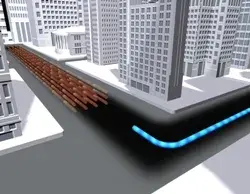 (August 7, 2009) Superconducting cables will mean a more powerful, more resilient electric grid
(August 7, 2009) Superconducting cables will mean a more powerful, more resilient electric grid
Most Americans take the electric current behind their power buttons for granted, assuming the power will be there when they are ready to juice an appliance or favorite tech toy, barring the occasional thunderstorm. The strain on our electric grid, which has led to rolling brownouts and a massive 2003 blackout that left 40 million people across the Northeast in the dark, will only intensify in the coming years.
Currently, the annual cost of power outages is approximately $80 billion, according to the Department of Energy. Add to conventional challenges the risks posed by terrorists intent on crippling our economy, and electrical engineers’ focus on developing technology to keep the grid online and recover faster, resonates.
A promising solution being developed is a superconductor cable that would link substations and allow them to share excess capacity during emergencies. This kind of flexibility strengthens the resiliency of the overall grid, reducing the likelihood of major power failures.
The U.S. Department of Homeland Security’s (DHS) Science and Technology Directorate (S&T) is currently funding such a cable, called an inherently fault current limiting (IFCL) superconductor cable, through its Resilient Electric Grid project. Working alongside electricity leaders from American Superconductor, Southwire, and Consolidated Edison, engineers are putting decades of existing electrical research into practice under the crowded streets of New York City. S&T managers and scientists recently participated in a successful test of the technology at the Oak Ridge National Laboratory in Tennessee.
“The IFCL superconducting cable being tested could well revolutionize power distribution to critical infrastructure,” said Dr. Roger McGinnis, Director of the Homeland Security Advanced Research Project Agency at S&T. “Eventually, these technologies will help incorporate localized clean, green electricity generation into the power grid.”
The benefits are simple: these cables can deliver more power, prevent power failures, and take up less physical space—all much-needed features in today’s dense and busy American cities.
The technology is capable of carrying 10 times as much power as copper wires of the same size, while also being able to automatically adapt to power surges and disruptions from lightning strikes, heat waves, and traffic accidents, even sabotage. A single superconductor cable can replace 12 copper cable bundles, freeing up more space underground for other utility needs like water, natural gas, or phone service.
And now for the science: the cables work by transmitting electricity with near zero resistance at higher temperatures than usual. “High” is a relative term among superconductors. The cables conduct electricity at a chill -320°F instead of an icy -460°F for traditional superconductor cables.
Holding and conducting energy better than traditional copper means these cables take up a fraction of the space. Manhattan’s electrical workers may be able to eventually clear out the subterranean congestion beneath Wall Street that amazingly, looks much the same today as it did a century ago.
Since the cables themselves better prevent extremely high currents from cascading through the system, they will help eliminate the power surges that can permanently damage electrical equipment, similar to a breaker switch in a home, explained McGinnis. The cable switches off during a surge or failure, but automatically resets when conditions return to normal.
For some context, electrical substations take electricity delivered over transmission and distribution lines and lower the voltage so it can be used by homes and businesses. Even if power is lost to an individual substation, by creating multiple, redundant paths for the electric current, the cables allow quick power restoration to all the surrounding power loads. Ultimately, these cables may allow substations that had been intentionally isolated from one another in the past, for fear of cascading failures, to be interconnected in order to share power and assets.
Cutting-edge high temperature superconducting cables have been successfully tested in laboratories, and can be found in a handful of demonstration projects around the country, but they remain an emerging technology. S&T is interested in advancing the technology so that it can be used nationwide, and is pursuing an opportunity to connect two Con Edison Manhattan substations with the cable.
The Department hopes to enable the Department of Energy and various utility companies around the country to eventually replace more than 2,000 circuit miles of power cables in U.S. cities with resilient, safe, and green IFCL cables.
To request more information about this story, please e-mail st.snapshots@hq.dhs.gov.
